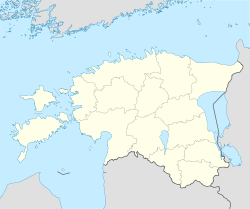- Dagö
-
<span id="selection_index3" class="selection_index"></span><span class="w">Hiiumaa</span> - <span class="w">Wikipédia</span> Hiiumaa
Hiiumaa Géographie Pays  Estonie
EstonieLocalisation Mer Baltique (océan Atlantique) Coordonnées Superficie 989 km2 Point culminant Tornimägi (68 m) Géologie Île continentale Administration  Estonie
EstonieRégion Hiiumaa Démographie Population 11 087 hab. Densité 11,21 hab./km2 Plus grande ville Kärdla Autres informations Fuseau horaire UTC+2 Îles d'Estonie Hiiumaa (Dagö en Suédois, Hiidenmaa en Finnois) est la deuxième plus grande île de l’Estonie, dans la Mer Baltique, au nord de l’île de Saaremaa.
Elle était la possession jusqu’en 1563 des Chevaliers Teutons (pour le compte de la Ligue hanséatique), puis de la Suède jusqu’en 1710, lorsque la Russie l’annexa.
Administrativement, l'île appartient en totalité à la région du même nom.
Liens externes
Géographie de Hiiumaa
Hiiumaa • Kassari • Luguse • TihuPolitique de Hiiumaa
Hannes MaaselVilles et villages du maakonnad de Hiiumaa
Aadma - Ala - Allika - Aruküla - Emmaste - Esiküla - Hagaste - Haldi - Haldreka - Harju (Emmaste) - Harju (Pühalepa) - Hausma - Heigi - Heiste - Heistesoo - Hellamaa - Heltermaa - Hiiessaare - Hilleste - Hindu - Hirmuste - Härma - Hüti - Isabella - Jausa - Jõeküla - Jõeranna - Jõesuu - Kaasiku - Kabuna - Kaderna - Kaigutsi - Kalana - Kaleste - Kalgi - Kanapeeksi - Kassari - Kauste - Kerema - Kidaste - Kiduspe - Kiivera - Kitsa - Kleemu - Kodeste - Kogri - Koidma - Kolga - Kopa - Kukka - Kuri - Kuriste - Kurisu (Emmaste) - Kurisu (Kõrgessaare) - Kuusiku - Kõlunõmme - Kõmmusselja - Kõpu - Külaküla - Külama - Laartsa - Laasi - Laheküla - Lassi - Lauka - Leerimetsa - Lehtma - Leigri - Leisu - Lelu - Lepiku - Ligema - Lilbi - Linnumäe - Loja - Luguse - Luidja - Lõbembe - Lõpe - Malvaste - Mangu - Mardihansu - Meelste - Metsaküla - Metsalauka - Metsapere - Moka - Muda - Mudaste - Mäeküla - Mäeltse - Mägipe - Männamaa - Mänspe - Määvli - Napi - Nasva - Niidiküla - Nurste - Nõmba - Nõmme (Kõrgessaare) - Nõmme (Käina) - Nõmmerga - Ogandi - Ojaküla - Ole - Orjaku - Otste - Palade - Palli - Paluküla - Paope - Partsi - Pihla - Pilpaküla - Poama - Prassi - Prählamäe - Prähnu - Puliste - Puski - Putkaste - Pärna - Pärnselja - Pühalepa - Rannaküla - Reheselja - Reigi - Reikama - Riidaküla - Risti - Ristivälja - Rootsi - Sakla - Salinõmme - Sarve - Selja (Emmaste) - Selja (Käina) - Sepaste - Sigala - Sinima - Soonlepa - Suuremõisa - Suurepsi - Suureranna - Suuresadama - Sõru - Sääre - Sülluste - Taguküla - Tahkuna - Tammela - Tammistu - Tareste - Taterma - Tempa - Tiharu - Tilga - Tohvri - Tubala - Tärkma - Ulja - Undama - Utu - Vaemla - Vahtrepa - Valgu - Valipe - Vanamõisa - Viilupi - Viiri - Viita - Viitasoo - Vilima - Vilivalla - Villamaa - Villemi - Värssu - Õngu - Ühtri - Ülendi- Portail des pays baltes
- Portail du monde maritime
Catégories : Île d'Estonie | Île de la mer Baltique | Île du golfe de Finlande
Wikimedia Foundation. 2010.

